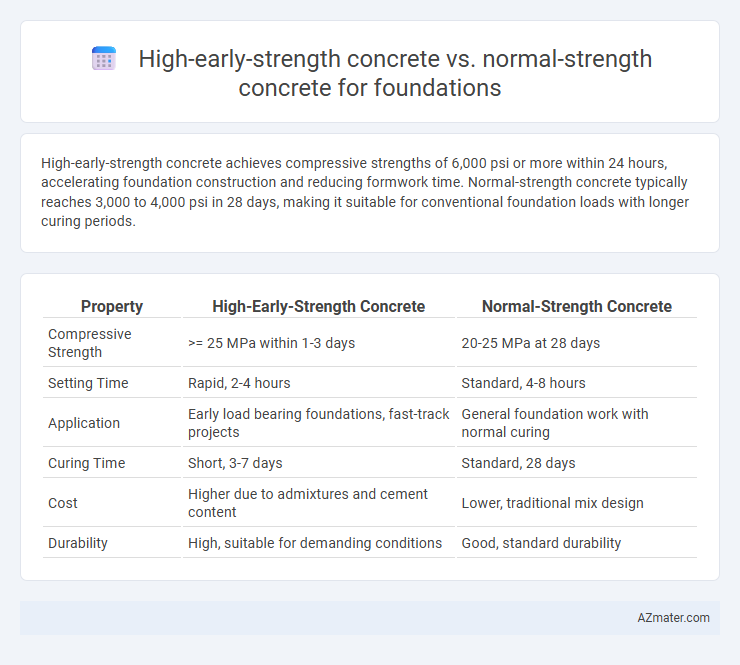High-early-strength concrete achieves compressive strengths of 6,000 psi or more within 24 hours, accelerating foundation construction and reducing formwork time. Normal-strength concrete typically reaches 3,000 to 4,000 psi in 28 days, making it suitable for conventional foundation loads with longer curing periods.
Table of Comparison
| Property | High-Early-Strength Concrete | Normal-Strength Concrete |
|---|---|---|
| Compressive Strength | >= 25 MPa within 1-3 days | 20-25 MPa at 28 days |
| Setting Time | Rapid, 2-4 hours | Standard, 4-8 hours |
| Application | Early load bearing foundations, fast-track projects | General foundation work with normal curing |
| Curing Time | Short, 3-7 days | Standard, 28 days |
| Cost | Higher due to admixtures and cement content | Lower, traditional mix design |
| Durability | High, suitable for demanding conditions | Good, standard durability |
Introduction to Concrete Types for Foundations
High-early-strength concrete gains significant strength within the first 24 hours, making it ideal for foundations requiring rapid load-bearing capacity and expedited construction schedules. Normal-strength concrete typically achieves its design strength over 28 days, offering durability and cost-effectiveness for standard foundation applications. Choosing between these types depends on project timelines, structural requirements, and environmental conditions affecting the curing process.
Defining High-Early-Strength Concrete
High-early-strength concrete achieves compressive strength significantly faster than normal-strength concrete, typically reaching 70% of its design strength within 24 hours. This accelerated strength development results from higher cement content, special admixtures, and optimized curing conditions. Its rapid setting and early load-bearing capability make it ideal for foundation work requiring quick construction cycles or early strain application.
Characteristics of Normal-Strength Concrete
Normal-strength concrete typically has a compressive strength ranging from 20 to 40 MPa and attains its design strength over a standard curing period of 28 days, making it suitable for general foundation applications. This type of concrete features a balanced mix of cement, water, and aggregates, providing moderate workability and durability, which supports load-bearing structures with steady strength development. Its slower strength gain compared to high-early-strength concrete allows for gradual load application and reduces the risk of thermal cracking in foundation elements.
Key Differences in Composition
High-early-strength concrete contains higher cement content and uses special chemical admixtures like accelerators, enabling it to achieve compressive strength of 6,000 psi or more within 24 hours, compared to normal-strength concrete which reaches approximately 3,000 to 4,000 psi over 28 days. The aggregate sizes in high-early-strength concrete are often finer and uniformly graded to enhance early hydration, while normal-strength concrete uses a broader range of aggregate sizes for cost efficiency. The water-cement ratio in high-early-strength concrete is carefully controlled below 0.40 to promote rapid strength gain, whereas normal-strength concrete typically has higher water content, around 0.45 to 0.60, balancing workability and long-term durability.
Setting and Curing Times: A Comparative Analysis
High-early-strength concrete achieves significant load-bearing capacity within 24 hours due to rapid hydration, making it ideal for foundations requiring quick formwork removal and accelerated construction schedules. Normal-strength concrete typically requires 7 to 28 days of curing to develop adequate strength, ensuring long-term durability and stability for conventional foundation projects. The accelerated setting and curing times of high-early-strength concrete reduce construction time but may require careful moisture and temperature control to prevent shrinkage and thermal cracking.
Strength Development and Long-Term Performance
High-early-strength concrete achieves compressive strengths above 20 MPa within 24 hours, enabling faster formwork removal and reduced construction time, while normal-strength concrete typically reaches similar strengths around 28 days. The rapid strength gain in high-early-strength concrete is due to its optimized cementitious composition and finer particle size distribution, which enhance hydration rates. Long-term performance of high-early-strength concrete generally matches or exceeds that of normal-strength concrete, maintaining durability and resistance to environmental stresses when properly cured.
Cost Implications and Budget Considerations
High-early-strength concrete accelerates construction schedules by achieving required strength within 24 hours, reducing labor and formwork rental costs, which can offset its higher material price compared to normal-strength concrete. Normal-strength concrete, typically gaining strength over 28 days, offers lower upfront material costs but may increase overall project expenses due to extended curing times and delayed construction milestones. Budget considerations must weigh the premium of high-early-strength concrete against potential savings from faster project completion and reduced time-dependent costs.
Applications in Foundation Construction
High-early-strength concrete accelerates the construction process by achieving necessary strength within 24 hours, making it ideal for time-sensitive foundation projects such as fast-track commercial buildings and repair works. Normal-strength concrete, with typical curing periods of 28 days, is suitable for standard foundation applications where extended curing time is acceptable, including residential buildings and infrastructure projects with longer schedules. The choice between these concretes depends on project timelines, load requirements, and environmental conditions impacting foundation durability.
Durability and Structural Safety Factors
High-early-strength concrete achieves rapid strength gain, enhancing early load-bearing capacity and reducing construction time, critical for foundation projects requiring quick turnaround and structural stability. Its dense microstructure improves durability by minimizing permeability and resistance to chemical attack, thereby extending foundation lifespan compared to normal-strength concrete. While normal-strength concrete offers reliable long-term performance, high-early-strength concrete provides superior early durability and safety factors essential for foundations subjected to dynamic loads or harsh environmental conditions.
Selecting the Right Concrete for Your Foundation
High-early-strength concrete gains strength rapidly within the first 24 hours, making it ideal for foundations requiring quick load-bearing capacity and accelerated construction schedules. Normal-strength concrete, typically achieving 28-day compressive strengths between 20 to 40 MPa, provides reliable durability for standard foundation projects without the premium cost associated with rapid curing admixtures. Selecting the right concrete depends on project timelines, load requirements, and budget constraints, with high-early-strength concrete suited for fast-track builds and normal-strength concrete preferred for conventional foundation applications.

Infographic: High-early-strength concrete vs Normal-strength concrete for Foundation
 azmater.com
azmater.com